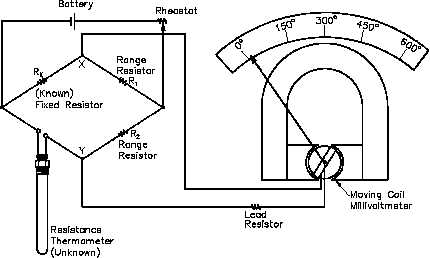TEMPERATURE DETECTION CIRCUITRY
Temperature Detectors
Bridge Circuit Operation
The bridge operates by placing Rx in the circuit, as shown in Figure 8, and then adjusting R3 so
that all current flows through the arms of the bridge circuit. When this condition exists, there
is no current flow through the ammeter, and the bridge is said to be balanced. When the bridge
is balanced, the currents through each of the arms are exactly proportional. They are equal if R1
= R2. Most of the time the bridge is constructed so that R1 = R2. When this is the case, and the
bridge is balanced, then the resistance of Rx is the same as R3, or Rx = R3.
When balance exists, R3 will be equal to the unknown resistance, even if the voltage source is
unstable or is not accurately known. A typical Wheatstone bridge has several dials used to vary
the resistance. Once the bridge is balanced, the dials can be read to find the value of R3. Bridge
circuits can be used to measure resistance to tenths or even hundredths of a percent accuracy.
When used to measure temperature, some Wheatstone bridges with precision resistors are
accurate to about + 0.1°F.
Two types of bridge circuits (unbalanced and balanced) are utilized in resistance thermometer
temperature detection circuits. The unbalanced bridge circuit (Figure 9) uses a millivoltmeter that
is calibrated in units of temperature that correspond to the RTD resistance.
Figure 9 Unbalanced Bridge Circuit
IC-01
Page 12
Rev. 0

